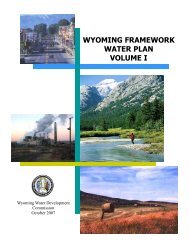Humpback chub (Gila cypha) - Upper Colorado River Endangered ...
Humpback chub (Gila cypha) - Upper Colorado River Endangered ...
Humpback chub (Gila cypha) - Upper Colorado River Endangered ...
Create successful ePaper yourself
Turn your PDF publications into a flip-book with our unique Google optimized e-Paper software.
Factor D—Adequate existing regulatory mechanisms.<br />
Implementation of regulatory mechanisms is necessary for recovery of the humpback <strong>chub</strong> and<br />
to ensure long-term conservation of the species. After removal from the list of species protected<br />
by the Act, the humpback <strong>chub</strong> and its habitat will continue to receive consideration and some<br />
protection through the following Federal laws and related state statutes: National Environmental<br />
Policy Act; Clean Water Act; Organic Act; and Fish and Wildlife Coordination Act.<br />
The need for conservation plans and agreements was identified to provide reasonable assurances<br />
that recovered humpback <strong>chub</strong> populations will be maintained.<br />
Criterion 9.<br />
Mechanisms determined adequate for legal protection of adequate habitat in the<br />
mainstem <strong>Colorado</strong> <strong>River</strong> through Grand Canyon and the Little <strong>Colorado</strong> <strong>River</strong><br />
should be developed.<br />
Status of Criterion 9. Criterion 9 has been met. The Grand Canyon Protection<br />
Act along with “law of the river,” including interstate compacts, provide flows<br />
through Grand Canyon to deliver to lower basin states and benefit the ecosystem<br />
overall. The Glen Canyon Dam Adaptive Management Work Group through its<br />
Technical Work Group and the biological opinion for the reoperation of Glen<br />
Canyon Dam is the mechanism in which these flows are protected and provided.<br />
A Little <strong>Colorado</strong> <strong>River</strong> watershed study is a basin-wide effort to define the<br />
problems, identify solutions and options related to protecting and increasing<br />
water supplies, preserve/enhance a more natural environment, and improve the<br />
health of the watershed. There are multiple jurisdictions over the water resources<br />
that are working to develop a coordinated management plan to optimize the water<br />
resources to meet the water needs.<br />
Criterion 10. Elements of conservation plans are identified that are necessary to provide for the<br />
long-term management and protection of humpback <strong>chub</strong> populations.<br />
Status of Criterion 10. Criterion 10 has not been met. Conservation plans and<br />
the necessary elements have not been developed.<br />
Factor E—Other natural or manmade factors for which protection has been provided.<br />
The potential role of pesticides and pollutants in suppressing populations of <strong>Gila</strong> were discussed<br />
by Wick et al. (1981). Potential spills of hazardous materials threaten some populations of<br />
humpback <strong>chub</strong>. All States have hazardous-materials spills emergency-response plans that<br />
provide a quick cleanup response to accidental spills. A preventive measure may include<br />
filtration systems in case of accidental spills of hazardous materials at the Cameron bridge<br />
crossing above occupied habitats.<br />
Criterion 11. State and Federal hazardous-materials spills emergency-response plans should be<br />
reviewed and modified to ensure adequate protection for humpback <strong>chub</strong><br />
populations from hazardous-materials spills.<br />
18
















